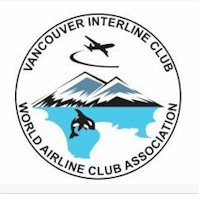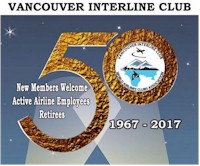 Where Eagles Dare
Where Eagles Dare
(Submitted by: Laurence Pitcher, NetLetter Subscriber)
French military using winged warriors to hunt down rogue drones. This is amazing.
Following incidents of drones flying over the presidential palace and restricted military sites – along with the deadly 2015 Paris terror attacks – the French Air Force has trained four golden eagles to intercept and destroy the rogue aircraft.
Aptly named d'Artagnan, Athos, Porthos and Aramis – an homage to Alexandre Dumas’ “The Three Musketeers” – the four birds of prey have been honing their attack skills at the Mont-de-Marsan in southwestern France since mid-2016.

A golden eagle grabs a flying drone during a military training exercise at Mont-de-Marsan French Air Force base, Southwestern France.

“A drone means food for these birds,” Gerald Machoukow, the military base's falconer, told us. “Now they automatically go after them.”
The use of hunting birds – normally falcons and northern goshawks – by military forces around the globe is common practice in the fight to scare other critters away from runways and so cut the risk of accidents during takeoff or landing. But it wasn’t until 2015 when the Dutch started using bald eagles to intercept drones that other militaries started to see the benefit of these winged warriors.
The French bred the four golden eagles – three males and one female -- using artificial insemination since eagles are a protected species and harvesting wild eggs is strictly forbidden. They chose the golden eagle because of the bird's hooked beak and sharp eyesight.
Also weighing in around 11 pounds, the birds are in a similar weight class as the drones they’re sent to destroy and clocking in at a top air speed of 50 miles per hour, with the capability of spotting its target from over a mile away, the eagles are deft hunters. To protect the eagles from drone blades and any explosive device that might be attached to them, the French military designed mittens of leather and Kevlar (an anti-blast material), to protect the bird’s talons.

A golden eagle carries a flying drone (2017).
"I love these birds," Machoukow told Agence France-Presse. "I don't want to send them to their death." The birds are first taught to attack in a straight line before graduating to diving from heights. Soon they’ll be patrolling the skies over the Pyrenees Mountains in southern France and could possibly be deployed at airports and special events, such as political summits and soccer tournaments. The French air force already expects four more eagles to join the fleet.
 Airtransit - A little piece of history
Airtransit - A little piece of history
It seems to be quite unusual, with the amazing access to information we have today, that information on any subject could be hard to find. However, I found myself in this situation while preparing the content provided by Terry for this edition of the NetLetter.
One of the images Terry sent is the cover of a timetable (from the collection of David Zekria) of a little-known airline named “Airtransit” that operated as a subsidiary of Air Canada during the early 1970’s. I even managed to stump a Google search as it only asked me if I was looking for “Air Transat”.
Airtransit was incorporated on June 19, 1973 to provide this service and operated six de Havilland DHC-6-300. The airline does not appear as one of the many legacy airlines in Air Canada’s history and rzjetz.net lists all six aircraft as being registered to Transport Canada. 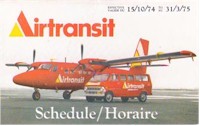
I did find a Wikipedia page on the Victoria STOLport (Short Takeoff and Landing) aerodrome built on the former Expo ’67 site in Montreal. A demonstration service flying between downtown Montreal and Rockcliffe Airport in Ottawa for a two-year period. While proof reading this issue, Ken Pickford noticed that there is a link on the bottom of the Wikipedia page to a Flight International article from November 28, 1974.
Ken also added his personal memory with this airline:
"I flew on Airtransit once from Montreal to Ottawa just for fun (one way only). As I was with CP then, can't remember whether we got reduced rates or whether I paid full fare. Probably the latter."
Apparently, the demonstration was not successful and was discontinued. Below are links to the limited amount of information that I have been able to find. Hopefully, we will hear from some more of our readers who may have personal experience with this time in history.
Wikipedia - Victoria STOLport
rzjetz.net - Airtransit fleet
SAE InternationalSAE International - Archived article announcing the service.
| Airtransit timetable interior | |
 |
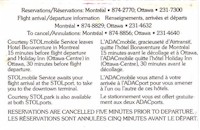 |
| Nattanya Andersen sent us this link to a YouTube video about the final flight of Southwest Captain Lee Carder who is joined by his two sons, also Southwest pilots. | |
|
Robert Arnold has sent us this discovery - I was at a flea market on the weekend and came across a very interesting hot jug. These were used in the galleys on TCA Viscounts. What makes this one so interesting? It’s painted all black and on the lid, in yellow painted text are the words, “If Found In Flight, Return to V/O, No.1 Hgr. YWG". On the front, facing the plug-in prongs, in white painted text, are the words “Test Only”. The guy who sold it to me didn’t have a clue what it was, or what it was used for, but I did know and, due to his lack of knowledge, he ended up selling it to me for 3 bucks. Not bad for a piece of airline history. I told him my wife would repurpose it as a flower vase. Long story short, no wife, no flowers. I wonder if any of your readers remember this item. It's made by Stiebel Eltron in Western Germany. Type HCL-1, No. H01S2, Watts, 560, Volts 28. |
|
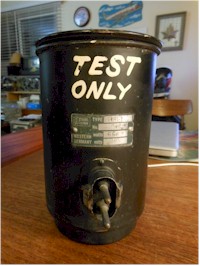 |
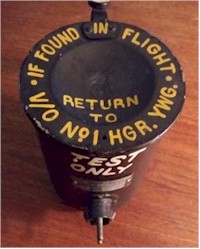 |
 |
 |
|
Neil Burton shares this information -
This photo was possibly taken in October 1936, when “Ginger” Coote was performing one of his many mercy flights in B.C. This particular flight was from the Vidette mine area, up Deadmans Creek and northwest of Kamloops Lake. Once they had an injured person on board, Coote was able to land at Kamloops within twenty minutes. His flying base at the time was on Gunn Lake, in the Bralorne area of B.C. Russell Leslie “Ginger” Coote and his father Andrew Leslie Coote (retired) were sole directors of the company, having bought out the other directors by mid-June 1935. Bridge River and Cariboo Airways Ltd.’s name was changed to Ginger Coote Airways Ltd. on April 16, 1938 and that name accepted by the B.C. registrar of companies on May 26, 1938. On April 20, 1938, George William Grant McConachie was appointed a director of Bridge River and Cariboo Airways Ltd. CF–AUX, piloted by 24-year-old Len Waagen and 3 passengers, a housewife and 2 men, perished in the crash of the aircraft on a flight from Vancouver to Zeballos, on the west coast of Vancouver Island, on May 27, 1938. The wreckage was not discovered until March 9, 1939, when come upon by two timber cruisers of Bloedel, Stewart and Welch. The site was about 15 miles west of Port Alberni, B.C., near Franklin River, down the Alberni Canal. |
|
|
Here is a photo of a poster for Ginger Coote Airways Ltd, which hung in the Bralorne-Pioneer Museum, on a visit to the museum in the summer of 2007. Research: Neil Burton |
|
|
|
|
(Can anyone throw any light on this item? - eds) |
|
PERX.com
Cruises
More interline deals at PERX.com brought to you by Interline Vacations 12708 Riata Vista Circle, Suite A-125, Austin, TX 78727 |
|
Ways to avoid paying too much to travel. (Source: MSN.COM) Flying Out During Off-Season If you’re looking to save big-time on travel, think about planning your vacations for the off-season. Consider the benefits beyond the slashed prices: less chaos at the airport, quieter resort grounds and enough in savings to consider planning another trip sooner than expected! |
|
Skipping the Travel Insurance It’s easy to skip the box that cites travel insurance when booking your flights, but never ignore the very real possibility that if something goes wrong, you’ve just denied yourself any kind of safety net. Travel insurance has come a long way (you may not even realize the coverage offered by your Credit Card Company or personal health insurance until you ask). Even a basic insurance plan will help protect you from not just health issues, but things like trip cancellation and lost luggage. |
|
Vancouver Interline Club was formed on February 28th 1967.
Elected were Evelyn Dunning (CPAL), President; Ron Groves (SAS), Vice President; Alma Kelly, Secretary; V. Patterson (JAL), Treasurer. |
|
(Source: VIC web site) |

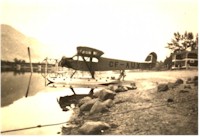
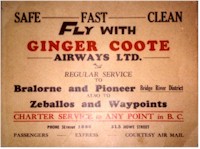
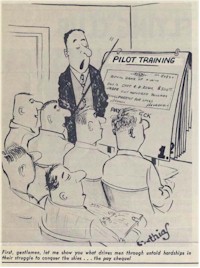

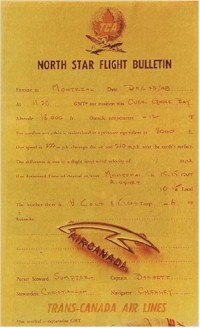 Please note the (Air Canada) insignia embossed on the North Star Flight Bulletin December 25, 1948 as shown in the en-Route magazine, 1987 50th anniversary edition.
Please note the (Air Canada) insignia embossed on the North Star Flight Bulletin December 25, 1948 as shown in the en-Route magazine, 1987 50th anniversary edition.  brought to you by Interline Vacations Get There Get Warm Resorts.
brought to you by Interline Vacations Get There Get Warm Resorts.